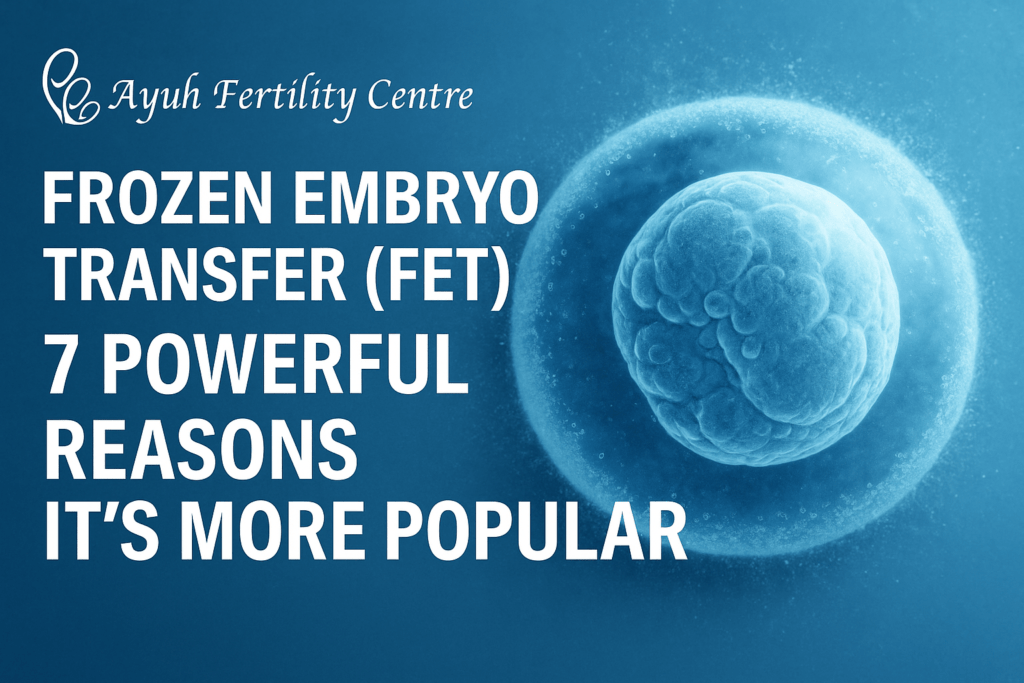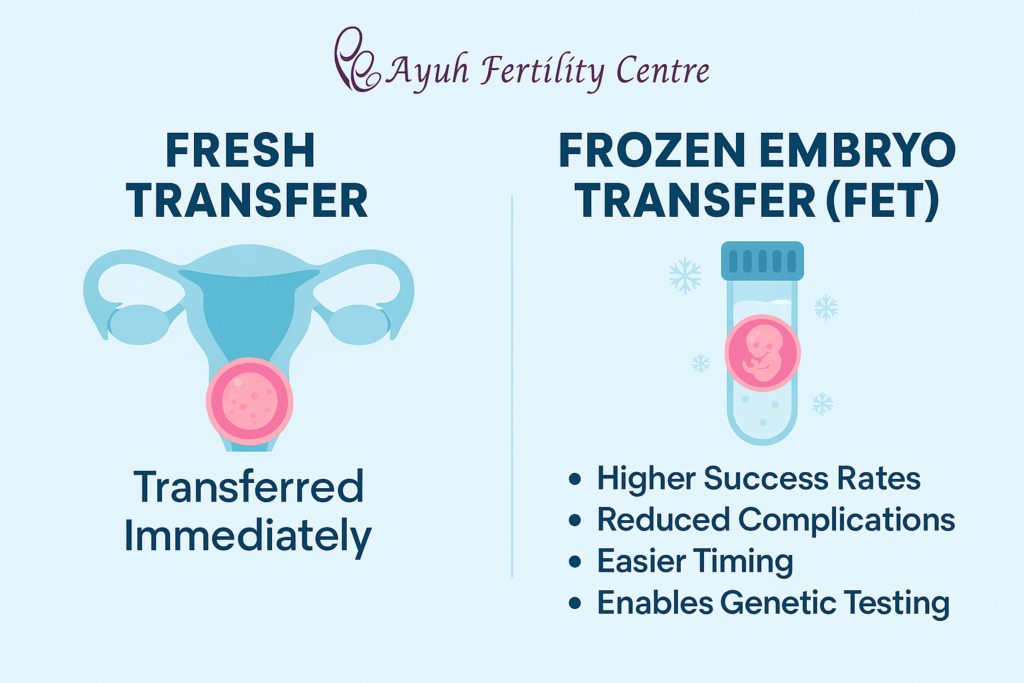When couples begin their IVF journey, one of the most common questions they face is: Should we go for a fresh embryo transfer or a frozen embryo transfer (FET)?
For years, fresh transfer was considered the “standard” method. But in recent times, more and more clinics—and patients—are turning to Frozen Embryo Transfer (FET) as the preferred choice.
At Ayuh Fertility Centre, Ahmedabad, we’ve seen this shift firsthand. Couples who struggled with fresh transfers often succeed with frozen ones. So, what’s driving this change? Let’s break it down in simple words.

What is Frozen Embryo Transfer (FET)?
Frozen Embryo Transfer (FET) is a method in IVF where embryos, created after fertilizing the eggs with sperm, are frozen using a process called vitrification (fast-freezing). These embryos are stored safely in liquid nitrogen at very low temperatures.
Instead of transferring embryos immediately (as in a fresh transfer), doctors wait until the woman’s body is fully prepared—her hormones are balanced, and the uterine lining is healthy and receptive. At that stage, the frozen embryos are thawed and transferred into the uterus.
👉 Think of it this way: if embryos are like seeds, then the uterus is the soil. FET allows doctors to “plant” the seeds only when the soil is fertile, calm, and ready to nurture growth.
At Ayuh Fertility Centre, Ahmedabad, we recommend FET for many women because it increases the chances of successful implantation and reduces stress on the body.
Fresh vs Frozen Transfer: What’s the Difference?
Let’s compare them in a simple way:
- Fresh Transfer
- Timing: Embryos are transferred 3–5 days after egg retrieval.
- Challenge: The woman’s body is still recovering from fertility medications, which may make the uterine lining less receptive.
- Advantage: It’s quicker—no freezing or thawing steps involved.
- Frozen Embryo Transfer (FET)
- Timing: Embryos are frozen and transferred later, when the uterus is hormonally stable.
- Advantage: The transfer happens in the best conditions, improving implantation chances. It also allows time for genetic testing (PGT-A), ensuring only healthy embryos are chosen.
- Flexibility: Couples can plan the timing around health, work, or emotional readiness.
👉 In short, fresh transfer is faster, but frozen transfer is often safer and more successful. That’s why FET is becoming the preferred choice for many couples today.
7 Powerful Reasons Frozen Embryo Transfer is More Popular
I’ll enrich a few with more detail:
1. Higher Success Rates
Studies now show that FET has slightly higher pregnancy rates than fresh transfers. This is because embryos are transferred into a hormonally balanced environment. For couples at Ayuh, FET has given renewed hope after failed fresh cycles.
3. More Flexibility & Control
Life doesn’t always run on a medical schedule. If a woman falls sick, needs surgery, or has an irregular cycle, frozen embryos remain safely stored. Couples can choose the right timing emotionally and physically, without worrying about “losing” a cycle.
4. Better Embryo Selection
When embryos are frozen, doctors can use time for advanced tests like Preimplantation Genetic Testing (PGT-A). This ensures only chromosomally normal embryos are transferred, reducing miscarriage risks and improving the chances of a healthy pregnancy.
6. Safer for Mothers and Babies
FET babies are often born with healthier birth weights and lower risk of complications compared to fresh transfer babies. Giving the mother’s body time to recover from IVF drugs allows the pregnancy to develop in a more natural, stable environment.
7. Emotional Comfort for Couples
IVF is stressful, and failed attempts can be devastating. FET provides more reassurance because the transfer happens under ideal conditions. Couples feel more confident, and this emotional support often makes a big difference.
Real Story from Ayuh Fertility Centre
One of our patients, Pooja (name changed), had 2 failed fresh transfers at another clinic. She was heartbroken. At Ayuh, we suggested trying Frozen Embryo Transfer. We waited until her hormones and uterine lining were perfectly ready. On her first FET, she conceived successfully. Today, she’s the mother of a healthy baby boy.
How Frozen Embryo Transfer Works – Step by Step
Let’s make it more relatable with simple comparisons:
- IVF Cycle: Eggs are collected and fertilized with sperm (like planting seeds).
- Embryo Freezing: Embryos are vitrified (frozen super quickly), protecting them from damage.
- Body Preparation: In a later cycle, the woman’s uterus is prepared with medicines to build a healthy lining (like preparing the soil).
- Thawing & Transfer: Embryos are gently thawed and placed in the uterus.
- Pregnancy Test: Around 10–14 days later, a blood test checks for pregnancy.
Lifestyle Habits to Improve FET Success
- Eat a fertility-friendly diet (fruits, veggies, lean proteins, whole grains).
- Avoid smoking & alcohol—both reduce IVF success.
- Get 7–8 hours of sleep daily.
- Practice yoga or meditation to manage stress.
- Maintain a healthy weight.
At Ayuh, we combine medical expertise with lifestyle guidance, ensuring couples have the highest chance of success.
🙋 5 FAQs | Frozen Embryo Transfer
Find answers to common questions about IVF treatments, success rates, and fertility care at Ayuh Fertility Centre, Ahmedabad.
1. Is Frozen Embryo Transfer more successful than fresh transfer?
Yes, many studies show that FET can be more successful. In a fresh cycle, the body is under stress from stimulation drugs, which may affect the uterine lining. With Frozen Embryo Transfer, embryos are transferred when the uterus is calm and hormonally balanced. At Ayuh Fertility Centre, we see better implantation, fewer complications, and healthier pregnancy outcomes with FET compared to fresh transfers.
2. Does freezing damage the embryos?
Not at all. With advanced vitrification techniques, embryos are frozen within seconds, preventing ice crystal formation that could harm cells. The survival rate of frozen embryos is above 95%, and babies born from frozen embryos are as healthy as those from fresh transfers. At Ayuh Fertility Centre, we use world-class technology to preserve embryo quality, so couples feel reassured that their chances remain high.
3. Who should choose Frozen Embryo Transfer?
FET is ideal for women with PCOS, those at risk of OHSS (Ovarian Hyperstimulation Syndrome), couples who want genetic testing (PGT-A), or patients with a history of failed fresh transfers. It’s also recommended when the uterine lining isn’t ready during IVF. At Ayuh, we evaluate every couple individually and recommend FET when it offers a safer, higher chance of success.
4. How long can embryos be stored?
Embryos can be frozen and stored for many years without losing quality. Some couples even return after 5–10 years to use their embryos successfully. At Ayuh Fertility Centre, frozen embryos are kept in liquid nitrogen tanks under strict safety and monitoring systems, giving couples flexibility, peace of mind, and hope for future family planning.
5. What can I do to improve my FET success chances?
Lifestyle plays a big role in Frozen Embryo Transfer success. Eating a fertility diet rich in fruits, vegetables, whole grains, and lean proteins helps nourish the body. Avoid smoking & alcohol, as both reduce implantation chances. Prioritize sleep, maintain a healthy weight, and manage stress through yoga or meditation. At Ayuh Fertility Centre, we combine these lifestyle tips with advanced FET care, ensuring couples are physically and emotionally ready for the best outcome.
Conclusion
Frozen Embryo Transfer (FET) is not just a trend—it’s becoming the new standard of IVF care. With higher success rates, reduced risks, and emotional reassurance, FET gives couples the best chance of achieving their dream of parenthood.
At Ayuh Fertility Centre, Ahmedabad, we specialize in advanced techniques like FET, genetic testing, and embryo monitoring, combined with personalized care. For us, it’s not just about science—it’s about giving couples hope, confidence, and joy.
💜 Life starts here—with the right choice, at the right time.


